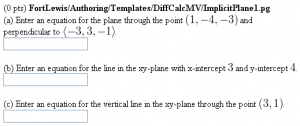Difference between revisions of "ImplicitPlane1"
(Created page with '<h2>Answer is an Equation for a Line or Plane</h2> 300px|thumb|right|Click to enlarge <p style="background-color:#f9f9f9;border:black solid 1px;paddi…') |
|||
| (3 intermediate revisions by one other user not shown) | |||
| Line 5: | Line 5: | ||
This PG code shows how to define an answer that is a line or plane. |
This PG code shows how to define an answer that is a line or plane. |
||
</p> |
</p> |
||
| − | * Download file: [[File:ImplicitPlane1.txt]] (change the file extension from txt to pg when you save it) |
||
| + | * File location in OPL: [https://github.com/openwebwork/webwork-open-problem-library/blob/master/OpenProblemLibrary/FortLewis/Authoring/Templates/DiffCalcMV/ImplicitPlane1.pg FortLewis/Authoring/Templates/DiffCalcMV/ImplicitPlane1.pg] |
||
| − | * |
+ | * PGML location in OPL: [https://github.com/openwebwork/webwork-open-problem-library/blob/master/OpenProblemLibrary/FortLewis/Authoring/Templates/DiffCalcMV/ImplicitPlane1_PGML.pg FortLewis/Authoring/Templates/DiffCalcMV/ImplicitPlane1_PGML.pg] |
<br clear="all" /> |
<br clear="all" /> |
||
| Line 83: | Line 83: | ||
<p> |
<p> |
||
<b>Setup:</b> |
<b>Setup:</b> |
||
| − | The first answer is a standard mulitivariable calculus question. There are several different ways to specify the input to <code>ImplicitPlane</code>, which are detailed in the [http://webwork.maa.org/pod/ |
+ | The first answer is a standard mulitivariable calculus question. There are several different ways to specify the input to <code>ImplicitPlane</code>, which are detailed in the [http://webwork.maa.org/pod/pg/macros/parserImplicitPlane.html POD documentation]. It is also possible to do some more complicated manipulations with the vectors and points, which is detailed in the [http://webwork.maa.org/wiki/ImplicitPlane problem techniques section]. |
</p> |
</p> |
||
<p> |
<p> |
||
| Line 154: | Line 154: | ||
Context()->texStrings; |
Context()->texStrings; |
||
BEGIN_SOLUTION |
BEGIN_SOLUTION |
||
| − | ${PAR}SOLUTION:${PAR} |
||
Solution explanation goes here. |
Solution explanation goes here. |
||
END_SOLUTION |
END_SOLUTION |
||
| Line 177: | Line 176: | ||
[[Category:Top]] |
[[Category:Top]] |
||
| − | [[Category: |
+ | [[Category:Sample Problems]] |
| + | [[Category:Subject Area Templates]] |
||
Revision as of 18:04, 7 April 2021
Answer is an Equation for a Line or Plane
This PG code shows how to define an answer that is a line or plane.
- File location in OPL: FortLewis/Authoring/Templates/DiffCalcMV/ImplicitPlane1.pg
- PGML location in OPL: FortLewis/Authoring/Templates/DiffCalcMV/ImplicitPlane1_PGML.pg
| PG problem file | Explanation |
|---|---|
|
Problem tagging: |
|
DOCUMENT(); loadMacros( "PGstandard.pl", "MathObjects.pl", "parserImplicitPlane.pl", "parserVectorUtils.pl", "AnswerFormatHelp.pl", ); TEXT(beginproblem()); |
Initialization: |
Context("ImplicitPlane");
$A = non_zero_point3D(-5,5,1);
$N = non_zero_vector3D(-5,5,1);
$answer1 = ImplicitPlane($A,$N);
Context()->variables->are(x=>"Real",y=>"Real");
$answer2 = ImplicitPlane("4x+3y=12");
$answer3 = ImplicitPlane("x=3");
|
Setup:
The first answer is a standard mulitivariable calculus question. There are several different ways to specify the input to
When the |
Context()->texStrings;
BEGIN_TEXT
(a) Enter an equation for the plane through
the point \( $A \) and perpendicular to
\( $N \).
$BR
\{ ans_rule(20) \}
\{ AnswerFormatHelp("equations") \}
$BR
$BR
(b) Enter an equation for the line in the
xy-plane with x-intercept \( 3 \) and
y-intercept \( 4 \).
$BR
\{ ans_rule(20) \}
\{ AnswerFormatHelp("equations") \}
$BR
$BR
(c) Enter an equation for the vertical line
in the xy-plane through the point \( (3,1) \).
$BR
\{ ans_rule(20) \}
\{ AnswerFormatHelp("equations") \}
END_TEXT
Context()->normalStrings;
|
Main Text: |
$showPartialCorrectAnswers = 1; ANS( $answer1->cmp() ); ANS( $answer2->cmp() ); ANS( $answer3->cmp() ); |
Answer Evaluation: |
Context()->texStrings;
BEGIN_SOLUTION
Solution explanation goes here.
END_SOLUTION
Context()->normalStrings;
COMMENT('MathObject version.');
ENDDOCUMENT();
|
Solution: |
